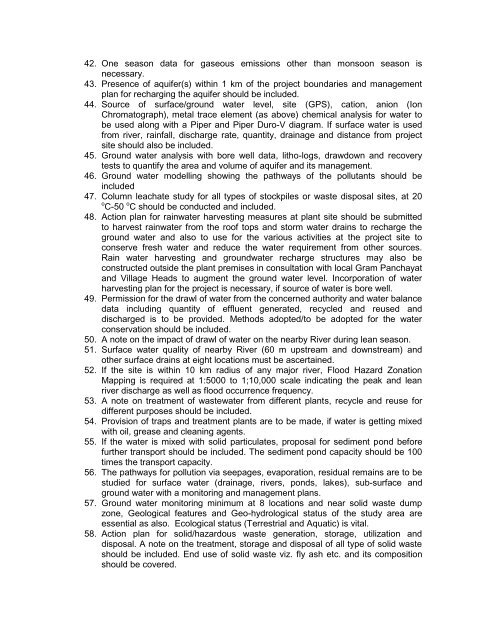MINUTES OF2ND RECONSTITUTED EXPERT APPRAISAL ...
MINUTES OF2ND RECONSTITUTED EXPERT APPRAISAL ...
MINUTES OF2ND RECONSTITUTED EXPERT APPRAISAL ...
- No tags were found...
Create successful ePaper yourself
Turn your PDF publications into a flip-book with our unique Google optimized e-Paper software.
42. One season data for gaseous emissions other than monsoon season isnecessary.43. Presence of aquifer(s) within 1 km of the project boundaries and managementplan for recharging the aquifer should be included.44. Source of surface/ground water level, site (GPS), cation, anion (IonChromatograph), metal trace element (as above) chemical analysis for water tobe used along with a Piper and Piper Duro-V diagram. If surface water is usedfrom river, rainfall, discharge rate, quantity, drainage and distance from projectsite should also be included.45. Ground water analysis with bore well data, litho-logs, drawdown and recoverytests to quantify the area and volume of aquifer and its management.46. Ground water modelling showing the pathways of the pollutants should beincluded47. Column leachate study for all types of stockpiles or waste disposal sites, at 20o C-50 o C should be conducted and included.48. Action plan for rainwater harvesting measures at plant site should be submittedto harvest rainwater from the roof tops and storm water drains to recharge theground water and also to use for the various activities at the project site toconserve fresh water and reduce the water requirement from other sources.Rain water harvesting and groundwater recharge structures may also beconstructed outside the plant premises in consultation with local Gram Panchayatand Village Heads to augment the ground water level. Incorporation of waterharvesting plan for the project is necessary, if source of water is bore well.49. Permission for the drawl of water from the concerned authority and water balancedata including quantity of effluent generated, recycled and reused anddischarged is to be provided. Methods adopted/to be adopted for the waterconservation should be included.50. A note on the impact of drawl of water on the nearby River during lean season.51. Surface water quality of nearby River (60 m upstream and downstream) andother surface drains at eight locations must be ascertained.52. If the site is within 10 km radius of any major river, Flood Hazard ZonationMapping is required at 1:5000 to 1;10,000 scale indicating the peak and leanriver discharge as well as flood occurrence frequency.53. A note on treatment of wastewater from different plants, recycle and reuse fordifferent purposes should be included.54. Provision of traps and treatment plants are to be made, if water is getting mixedwith oil, grease and cleaning agents.55. If the water is mixed with solid particulates, proposal for sediment pond beforefurther transport should be included. The sediment pond capacity should be 100times the transport capacity.56. The pathways for pollution via seepages, evaporation, residual remains are to bestudied for surface water (drainage, rivers, ponds, lakes), sub-surface andground water with a monitoring and management plans.57. Ground water monitoring minimum at 8 locations and near solid waste dumpzone, Geological features and Geo-hydrological status of the study area areessential as also. Ecological status (Terrestrial and Aquatic) is vital.58. Action plan for solid/hazardous waste generation, storage, utilization anddisposal. A note on the treatment, storage and disposal of all type of solid wasteshould be included. End use of solid waste viz. fly ash etc. and its compositionshould be covered.
















